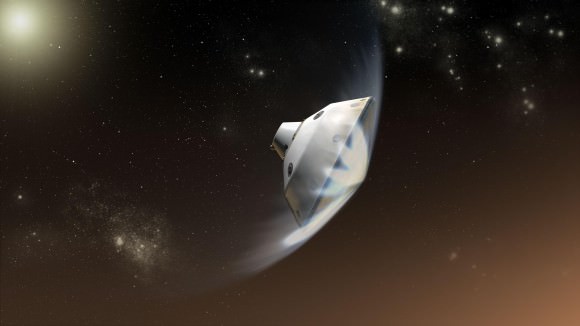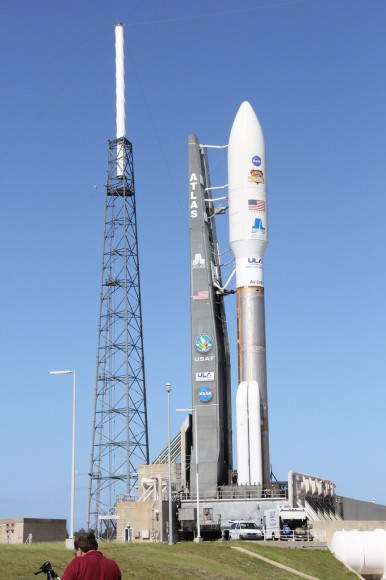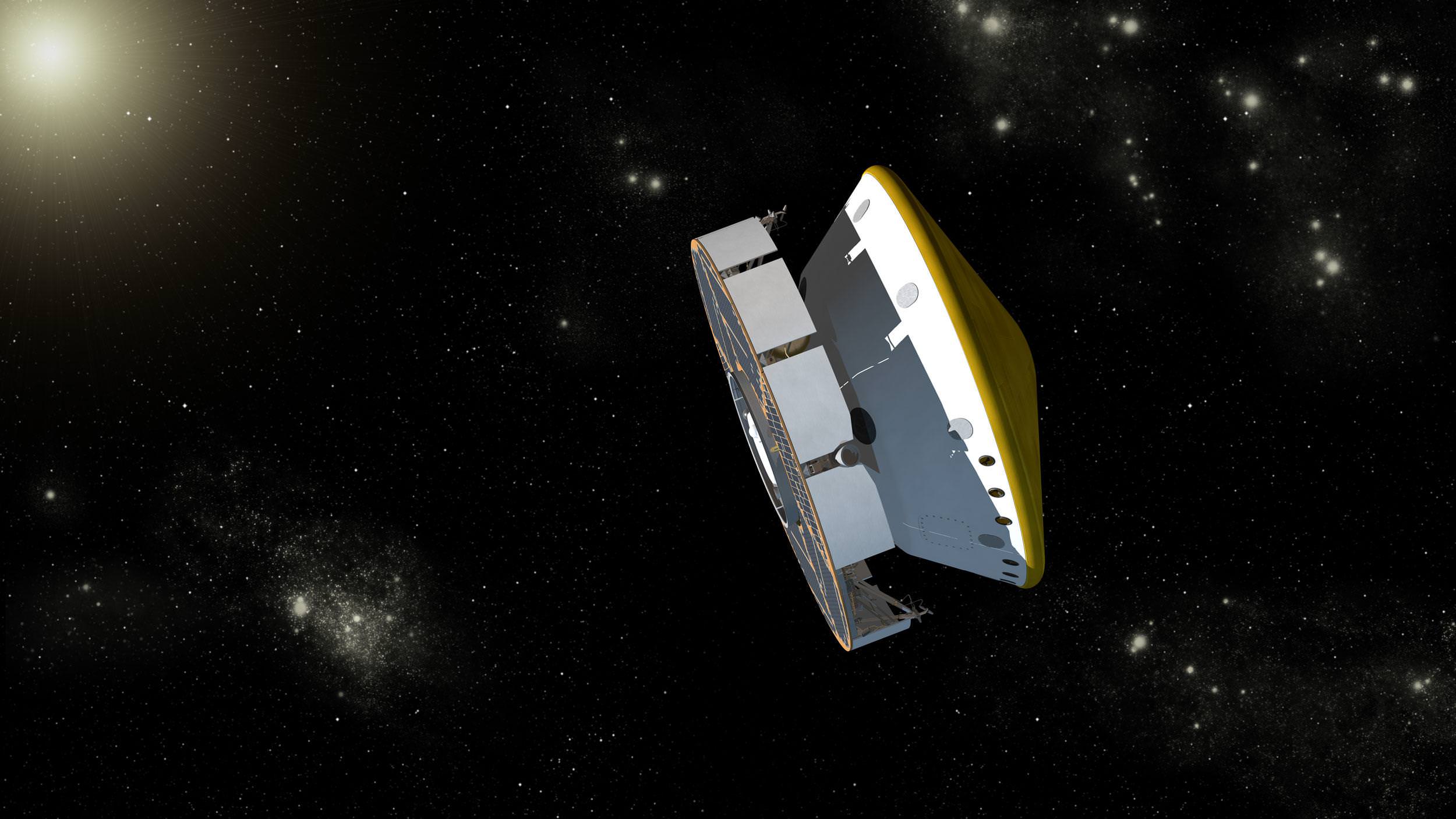[/caption]
Curiosity’s interplanetary injection was spot on ! – following her Nov. 26 blastoff aboard the 2 million pound thrust Atlas V booster from Cape Canaveral in Florida.
For a birds-eye view of where it all started, watch the cool close-up launch video, below taken from within the Atlas pad security fence.
Indeed the launch precision was so good that mission controllers at NASA’s Jet Propulsion Lab in Pasadsena, Calif., have announced they postponed the first of six planned course correction burns for the agency’s newest Mars rover by at least a month. The firing had been planned for some two weeks after liftoff.
Curiosity is merrily sailing on a 254 day and 352-million-mile (567-million-kilometer) interplanetary flight from the Earth to Mars that will culminate on August 6, 2012 with a dramatic first-of-its-kind precision rocket powered touchdown inside Gale Crater.
“This was among the most accurate interplanetary injections ever,” said Louis D’Amario of NASA’s Jet Propulsion Laboratory, Pasadena, Calif. He is the mission design and navigation manager for the Mars Science Laboratory.
Video Caption: View from inside the Pad 41 Security Fence at Cape Canaveral. Shot by a Canon 7D still camera during the launch of the Atlas V rocket carrying the MSL Curiosity rover to Mars. Thanks to a sound trigger my camera started firing at three frames per second from just after main engine ignition up until the exhaust plume finally envelops the camera and deadens all sound around it. The frames have been slowed down quite a bit for dramatic effect. Enjoy seeing what it is like for us media personnel who set out our remote cameras for launches at Kennedy Space Center and Cape Canaveral, Florida. Credit: Chase Clark/shuttlephotos.com
As of midday Friday, Dec. 2, the spacecraft had already traveled 10.8 million miles (17.3 million kilometers) and is moving at 7,500 mph (12,000 kilometers per hour) relative to Earth and at 73,800 mph (118,700 kilometers per hour) relative to the sun.
An interesting fact is that engineers deliberately planned the spacecraft’s initial trajectory to miss Mars by about 35,000 miles (56,400 kilometers) so that the Centaur upper stage does not hit Mars by accident. Both Centaur and Curiosity are currently following the same trajectory through the vast void of space and the actual trajectory puts them on course to miss Mars by about 38,000 miles (61,200 kilometers).
The Centaur has not been thoroughly cleaned of earthly microbes in the same way as Curiosity – and therefore cannot be permitted to impact the Martian surface and potentially contaminate the very studies Curiosity seeks to carry out in searching for the “Signs of Life”.
For the 8.5 month voyage to Mars, Curiosity and the rocket powered descent stage are tucked inside an aeroshell and are attached to the huge solar powered cruise stage.

Artist's Concept depicts the interaction of NASA's Mars Science Laboratory spacecraft with the upper atmosphere of Mars during the entry, descent and landing (EDL) of the Curiosity rover onto the Martian surface. EDL begins when the spacecraft reaches the top of Martian atmosphere, about 81 miles (131 kilometers) above the surface of the Gale crater landing area, and ends with the rover safe and sound on the surface of Mars some 7 minutes later. During EDL, the spacecraft decelerates from a velocity of about 13,200 miles per hour (5,900 meters per second) at the top of the atmosphere, to stationary on the surface. Credit: NASA/JPL-Caltech
The cruise stage is rotating at 2.05 rounds per minutes and is continuously generating electric power – currently about 800 watts – from the gleaming solar arrays. It also houses eight miniature hydrazine fueled thrusters. The propellant is stored inside titanium tanks.

The historic voyage of the largest and most sophisticated Martian rover ever built by humans seeks to determine if Mars ever offered conditions favorable for the genesis of microbial life.
Curiosity is packed to the gills with 10 state of the art science instruments that are seeking to detect the signs of life in the form of organic molecules – the carbon based building blocks of life as we know it.
The car sized robot is equipped with a drill and scoop at the end of its 7 ft long robotic arm to gather soil and powdered samples of rock interiors, then sieve and parcel out these samples into two distinct analytical laboratory instruments inside the rover.
Complete Coverage of Curiosity – NASA’s Next Mars Rover launched 26 Nov. 2011
Read continuing features about Curiosity by Ken Kremer starting here:
NASA Planetary Science Trio Honored as ‘Best of What’s New’ in 2011- Curiosity/Dawn/MESSENGER
Curiosity Mars Rover Launch Gallery – Photos and Videos
Curiosity Majestically Blasts off on ‘Mars Trek’ to ascertain ‘Are We Alone?
Mars Trek – Curiosity Poised to Search for Signs of Life
Curiosity Rover ‘Locked and Loaded’ for Quantum Leap in Pursuit of Martian Microbial Life
Science Rich Gale Crater and NASA’s Curiosity Mars Rover in Glorious 3-D – Touchdown in a Habitable Zone
Curiosity Powered Up for Martian Voyage on Nov. 26 – Exclusive Message from Chief Engineer Rob Manning
NASA’s Curiosity Set to Search for Signs of Martian Life
Curiosity Rover Bolted to Atlas Rocket – In Search of Martian Microbial Habitats
Closing the Clamshell on a Martian Curiosity
Curiosity Buttoned Up for Martian Voyage in Search of Life’s Ingredients
Assembling Curiosity’s Rocket to Mars
Encapsulating Curiosity for Martian Flight Test
Dramatic New NASA Animation Depicts Next Mars Rover in Action


I wish they could film the touch-down. It’d be a great advertisement for engineering careers.
.. in a sad contrast to the russian probe.
Always buy American made!
Dammit… don’t jinx it! We don’t need the word ‘flawless’ bantered about so early in the mission yet, it makes me nervous. ;-D
I am just wondering, how does a space craft in deep space determine it’s position?
I mean you are far away from a nearby object and there is no paralax unless you measure it over multiple days. Signal timing could do it but that is only measuring the distance, not really accurate for the 3D position.
It’s my understanding that it’s tracked from Earth using the Deep Space Network – the probe itself doesn’t do any calculations. I think the topic warrants an article on UT though because I would quite like to learn more about it 🙂
We have already written about the navigation and tracking of MSL here: http://www.universetoday.com/91254/how-will-msl-navigate-to-mars-very-precisely/
isnt that what they make magnets for ? put on a piece of paper and settle some iron filings on it and there you go – north and south .
They use GPS.
“Please turn right at the next exit. Slow down; there is a cop behind the asteroid.”
Check out this link: http://www2.jpl.nasa.gov/basics/bsf13-1.php
Also, google ‘spacecraft navigation’, and look for the NASA Bascis of Spaceflight booklet.
Basically, they use a combination of:
1) optical positions of quasars (a fixed reference frame) and compare these to the positions of other objects in the Solar System with known positions,
2) Dead-reckoning based on the velocity information provided by doppler shift of transmissions by the spacecraft
3) Time of flight for signals bouncing between the spacecraft and Earth gives the spacecraft distance from Earth too.
All of this info is fed into sophisticated computer programs that calculate the most likely position of the spacecraft at any given time, and project its trajectory into the future using basic physics.
Nice explanation!
quasars as reference to measure the angle to the spacecraft and not have to rely on the mechanical hardware to give you the angle.
Doppler shift to measure speed, I forgot this one.
Unlike Opportunity, Curiosity runs on nuclear power and so its lifespan seems more predictable. No energizer-bunny scenario here..